Our Top 10 Favourite Walks in North Devon & Exmoor
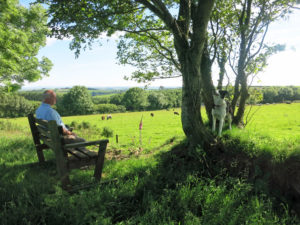
Bench with view on Huxtable Farm Devon Wildlife Walk
1) The 1 and 3/4 mile walk around Huxtable Farm’s Devon Wildlife Farm Trail
Walk; through woodland – where you may spot deer; to on hill top pastures – where you get panoramic views towards Dartmoor whilst buzzards and kites soaring over head; down a steep bracken covered valley, with badger set and a variety of moths & butterflies; next to the pond and stream watching dragonflies.
2) Huxtable Farm B&B to The Jack Russell Pub, Swimbridge
(once the home of the Reverend Jack Russell who founded the dog), along some quiet Devon country lanes. Approx 4.5 miles each way.
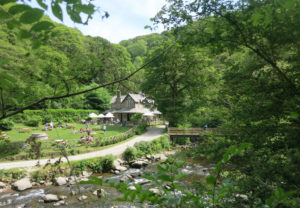
Watersmeet Exmoor
3) Watersmeet to Lynmouth or Rockford
Visit to Watersmeet’s original fishing lodge, North Devon’s National Trust shop and café serving delicious Whortleberry cream teas. Ramble up stream along side the East Lyn riverbank through awe-inspiring ancient woodland to the charming Rockford Inn – a remote riverside pub with some tasty bites to eat. Approx 2 miles each way. Alternatively walk down stream, approx. 2.5 miles each way, to the historic harbour of Lynmouth with its cliff railway to Lynton.
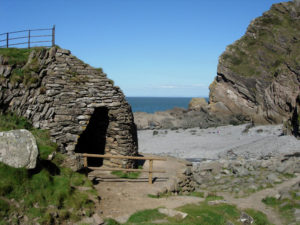
Heddens Mouth Lime Kiln on beach
4) Hunters Inn to Heddons Mouth
A beautiful walk through ancient woodland alongside the River Heddon, between some of England’s highest cliffs, to where it meets the sea and you will find a restored 19th century lime kiln on the beach. Designated a Site of Special Scientific Interest, the Heddon Valley is home to a variety of wildlife including otters and the rare high brown fritillary butterfly. Approx 1.5 miles each way
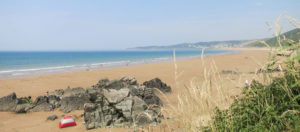
Putsborough to Woolacombe Beach
5) Putsborough to Woolacombe Beach Walk (or visa versa)
Approx 3.5 miles each way along golden sands, with views of Lundy Island and dunes at the back of the beach to explore. During World War Two the beach looked remarkably different as it was protected by barbed wire and was even used for US assault training in preparation for D-Day.
6) Northam Burrow to Westward Ho!
Northam Burrows Country Park lies to the west of the River Taw Estuary within ‘North Devon’s Area of Outstanding Natural Beauty’. It is about 253 hectares of grassy coastal plain with salt marsh, sand dunes and generally unimproved grasslands, that also has England’s oldest golf course ‘The Royal North Devon Golf Club’
A pebble ridge separates the 2 miles of golden sands stretching to Westward Ho! from Northam Burrows
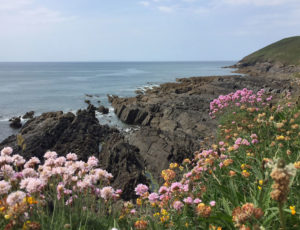
National Trust Baggy Point
7) Baggy Point National Trust Walk
NT car park on the peninsula to the right (as you look out to sea) of Croyde Beach
A two mile walk to the peninsula point, past some bones which are the remains of a large whale that was washed up on Croyde Beach in 1915.
On a clear day you can see Lundy Island and breathtaking views across bays to Hartland Point. You may also have the chance to watch some people coasteering (supervised jumping off the rocks into the sea) or some of the many rock climbers that come to Baggy Point to take advantage of the variety of routes it offers.
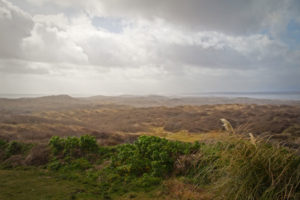
Braunton Burrows
8) Morte Point and Bull Point Lighthouse National Trust Walk
Enjoy the dramatic cliffs, rocky headlands and sandy bays, once notorious for smugglers and wreckers. The coastal heathland and maritime grasslands are home to a variety of birds and wildlife. Look out for seals basking on the rocks below as you walk from Morte Point towards Bull Point, past the secluded cove of Rockham Bay. Approx 4 miles
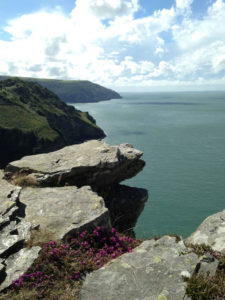
Valley of Rocks coastal view
9) Braunton Burrows to Crow point
Approx 2miles each way from the Braunton March Car Part to Crow Point. Braunton Burrows, is the largest sand dune system in Britain and the first United Nations Unesco Biosphere Reserve in Britain. The burrows are rich in wildlife, especially insects and butterflies, and have an internationally recognized abundance of rare and in some cases unique flora and fauna. The beach walk round Crow Point headland is situated at the end of the Burrows, where the River Taw and River Torridge estuaries meet the Atlantic Ocean.
10) Lynton to the Valley of the Rocks
Approx 3 miles from Lynton Cliff Railway to the Valley of Rocks, with its spectacular unique rock formations and herd of feral goats, grazing amongst the bracken and heathers.